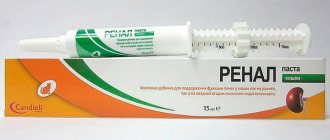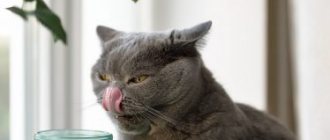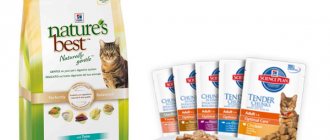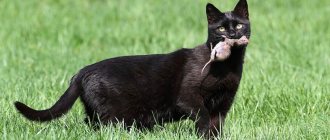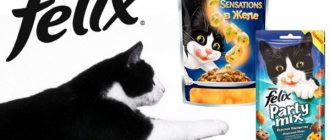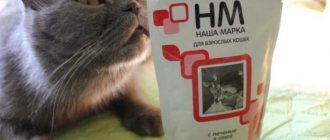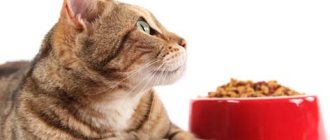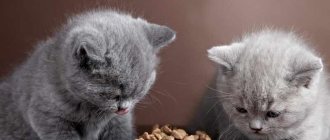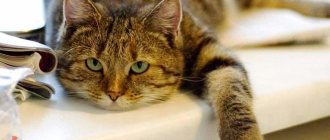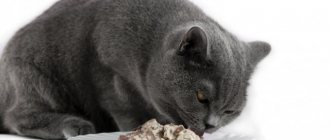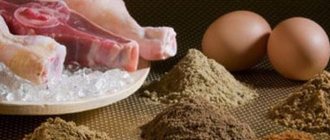Veterinary cat food is used to reduce the load on diseased organs during therapy and in the presence of chronic diseases in animals. Specialized nutrition in most cases does not eliminate the pathology by itself, but helps speed up treatment and prolongs remission. It is important to choose the right food, since an unsuitable diet can worsen your pet’s condition.
- 2 Types of medicinal food for cats
- 3 Table: brands of veterinary feeds
- 4 Reviews from veterinarians about medicinal foods
- 5 Reviews from animal owners about veterinary food
Causes
There are acute and chronic renal failure in cats. The course depends on the cause of origin, as well as the speed of development of symptoms. The whole variety of factors leading to the development of the disease is usually divided into two categories: renal and prerenal.
Real reasons:
- the action of toxins coming from outside,
- allergic effects of certain medications, for example, sulfonamides,
- infectious processes affecting the excretory organs.
Prerenal factors are directly related to dehydration of the body and destruction of red blood cells, which, for example, is observed during infection with leptospirosis or blood parasites.
Maintaining fluid balance in the cat's body.
Feeding wet food allows you to increase the amount of fluid. However, the cat may still not consume enough water to compensate for the fluid excreted in the urine. In such cases, additional measures are needed:
- Provide your cat with constant access to fresh water. You can stimulate water consumption by offering your cat dishes of different sizes, made of different materials, etc.;
- Use water flavors that smell like chicken, tuna, etc.
- Use drinking fountains—some cats prefer running water;
- Add water to food (if this does not discourage the cat's appetite);
- Provide intravenous fluid therapy periodically at the veterinary clinic;
- Perform subcutaneous infusion therapy periodically (in a veterinary clinic or at home);
If your cat's blood levels remain high despite a low-phosphate diet, using a phosphate-binding food additive (such as lanthanum or calcium acetate) may be helpful. A decrease in the concentration of phosphates in the blood provides a good protective effect for the kidneys in chronic renal failure.
Potassium supplements.
Some cats with chronic renal failure have low blood potassium levels. This leads to muscle weakening and loss of appetite, which, in turn, accelerates the development of chronic renal failure. If potassium levels are found to be low, a feed supplement containing potassium (usually potassium gluconate tablets, gel or powder) can increase them.
Cats with chronic kidney disease have a significantly increased risk of developing hypertension (high blood pressure). This can have dramatic consequences, including blindness and deterioration of the kidneys. Ideally, blood pressure should be checked in all cats with renal failure and treated if elevated. Typically, medications belonging to the group of vasodilators (vasodilators) are used. A drug called amlodipine is particularly effective for cats, but other medications may be used.
Treatment of anemia.
As chronic kidney disease progresses, cats often become anemic. It can be caused by insufficient production of the hormone erythropoietin by the kidneys, which stimulates the production of red blood cells in the bone marrow. There may be other causes, such as bleeding in the intestines. In severe cases, anemia can cause lethargy and weakness, significantly reducing the cat's quality of life.
Progressive chronic renal failure in cats is often accompanied by vomiting, nausea and loss of appetite, which significantly reduces quality of life. Various drugs are used for treatment, such as maropitant, famotidine and ranitidine.
Types of kidney failure
1 :
- acute - with acute renal failure it is possible to restore kidney function;
- chronic - kidney tissue degenerates into connective tissue. The process is irreversible; the kidneys do not restore function.
Classification 2 (according to causes):
- to renal. The cause of kidney dysfunction is impaired blood supply due to severe dehydration or prolonged exposure to anesthesia.
- after renal. It occurs against the background of an abnormal outflow of urine caused by urolithiasis (blockage of the urinary tract).
- actual renal failure. Occurs after poisoning with a toxic substance and is a consequence of chronic diseases (in particular, chronic kidney inflammation).
About nutrition for cats with kidney disease
Kidney failure in cats is the result of pathological processes and leads to a malfunction of the organ and the entire urinary system. With this disease, gradual damage to all organs occurs. Metabolic processes in the body are disrupted.
At the first stage of the disease, the amount of urine excreted decreases. There is a sharp decrease in blood pressure. As the disease develops, urine production ceases completely. The content of nitrogenous metabolites in the blood plasma increases significantly. At the third stage of the development of the disease, urine begins to leave, but it contains only salt and water, and metabolic products settle in the body and over time begin to destroy it.
Timely treatment helps normalize kidney function. Therapy for renal failure is long-term and lasts up to three months.
Kidney failure in cats can be acute or chronic. The first form of the disease is curable and develops intensively. The second occurs slowly and gradually affects the tissue of the kidney organ. This disease is incurable, and cat owners can only partially alleviate the animal’s condition.
Food for cats with renal failure contains minimal amounts of protein. Therefore, when creating a menu, you should limit your meat consumption by 30-50%. It is acceptable to replace meat products with offal, for example, chicken stomachs and hearts. The animal's diet should include yogurt and cottage cheese. To replenish the required calorie content, the menu is filled with cereal porridges and vegetable purees. Your pet can eat plant foods as much as possible.
If you have kidney disease, do not overfeed your cat. In case of renal failure, the menu is drawn up by the doctor, based on the animal’s condition and tests. In some cases, medicated food for cats with renal failure is included in the diet. Dietary food, especially wet food, as well as natural food, can significantly alleviate the animal’s condition. What to choose: natural food or ready-made food - the veterinarian must decide, based on the condition of the animal and the financial capabilities of its owner.
Why is diet necessary?
Kidney failure poses a threat to your cat's health and life.
In case of pathology in a sick cat, products resulting from metabolic processes accumulate in the body. The content of toxic components in the blood increases, as a result of which the animal may die. The disease in cats occurs in acute or chronic form. In the first case, it is possible to cope with kidney failure by following a proper diet and taking the necessary medications. The chronic type of the disease is characterized by slow progression, while the tissues of the internal organ are irreversibly damaged. The diet is selected individually for each cat by a veterinarian. There are 2 types of diet food:
- natural;
- ready-made feed.
Veterinarians warn owners that nutrition in case of kidney failure in a cat must be strictly observed, since the disease progresses quickly and leads to complications at the slightest disturbance.
Often, with kidney pathology, the pet does not eat anything; in this case, you need to try to compromise or force feed the animal. Hunger strikes should not be allowed under any circumstances, since there is a high probability of liver disorders being associated with renal failure.
Criterias of choice
Specialized stores offer a wide range of medicinal foods for ICD, ranging from economy to holistic class. Since budget foods rarely contain useful substances and microelements, veterinarians strongly advise against purchasing them, since they do not provide any benefit to your pet. The best option is to use products of super-premium class and higher.
Royal Canin Urinary
When choosing food for the treatment of urolithiasis in cats, you should pay attention to the following features:
- Each package must have a special mark that the product is intended for animals with ICD, and also indicate what type of stones it is suitable for;
- The food must contain retinol (vitamin A) and tocopherol (vitamin E);
- Medicinal food should not contain a high content of vitamin C, since ascorbic acid promotes the formation of stones.
To select the optimal food, the breeder is recommended to consult with a veterinarian before purchasing a particular product. The doctor will not only help you decide on the choice of food, but will also tell you what the daily dosage should be depending on the condition of the animal.
On a note! It is necessary to select medicinal food taking into account the type of stones formed, which is determined on the basis of laboratory tests.
Why medicated food is not cheap
As a rule, all special veterinary foods belong to the premium or super-premium class. The price cannot be low due to the high content of expensive components, in particular poultry or rabbit meat. Conscientious producers do not use spoiled products, do not replace meat and meat by-products with bone meal, and enrich the compositions with all important microelements and vitamins.
Cheapness always indicates the “dilution” of high-quality animal protein with plant protein or savings on raw materials. This is not so critical for healthy, strong animals, especially those walking outside, with access to additional food. When choosing a diet for a sick domestic cat, we are talking not only about its well-being, but also about its lifespan. Saving in this case will bring problems and grief to the owner.
The best manufacturers of Renal cat food
Dry cat food with low protein and phosphorus content is marked “Renal” for the convenience of buyers. High-quality therapeutic lines produce:
- Farmina
. An Italian brand that produces products for any age, breed, size, physiological condition, as well as dietary lines for various pathologies (obesity, diabetes, urolithiasis, chronic renal failure). Conducts research jointly with the Department of Veterinary Nutrition at the University of Naples. Federico ll, collaborates with independent veterinary hospitals.
- Purina
. A separate division of the Swiss corporation Nestlé, specializing in the production of pet food. Offers dry food, pates, pouches from economy to super-premium classes, including veterinary lines. Products are divided into corresponding brands: Cat Chow, Gourmet, Pro Plan, Pro Plan Veterinary Diets, ONE, Felix, Friskies.
- Hill's
. An American company offering balanced, biologically based nutrition for every stage of a cat's life. The range includes special food for sterilized, young and aged animals, hair removal, maintaining optimal weight, and therapeutic diets.
- Brit
. Manufacturer from the Czech Republic, producing premium cat food without genetically modified organisms, dyes, or preservatives. Particular attention is paid to the production of holistic and therapeutic diets. There is specialized food for certain breeds (short-haired, long-haired, Siamese).
- Monge
. Another Italian developer of premium and super-premium food for pets. Sells food for the daily diet of healthy pets, as well as for various diseases of the gastrointestinal tract, joints, urinary and cardiovascular systems. There are lines for rehabilitation after operations, reducing excess body weight, and solving dermatological problems.
- Trovet
. A Dutch company that specializes in dietary nutrition. Produces maintenance diets, functional treats, and feed additives. Offers a wide range of products for elimination (weight loss) and antiallergic diets.
- Royal Canin
. French manufacturer of daily and dietary food for pets of different ages and breeds. The range includes special food for diabetics, allergy sufferers, animals with kidney and heart failure, problems with the gastrointestinal tract, joints, teeth, as well as pregnant (nursing) cats.
Signs of illness
Acute form
Despite the wide variety of cause-and-effect factors, the symptoms of acute renal failure in a cat are the same. At the beginning of the inflammatory process, signs characteristic of the underlying disease are observed. But soon they are mixed with kidney disorders, which can lead to death.
Thirst in kidney failure
Conventionally, the course of the disease can be divided into four successive stages:
- initial,
- anuric (cessation of urine excretion or excretion in negligible quantities),
- restoration of urination,
- recovery.
Let's look at all the stages in more detail.
Stage I. Symptoms of the initial stage may go unnoticed, since during this period the signs of the underlying disease will predominate. But at this time, changes are already taking place that are imperceptible at first glance: blood circulation in the kidneys is disrupted due to shifts in hemodynamics (pressure jumps, heart function speeds up or slows down, etc.). The stage lasts from several hours to several days.
Stage II. The anuric or oliguric stage is the manifestation of typical signs of renal failure in cats; characterized by cessation of diuresis and increasing signs of uremia:
- drowsiness,
- lethargy,
- immobility,
- diarrhea,
- high blood pressure,
- rapid heartbeat,
- swelling,
- muscle cramps,
- the heart may stop.
If urine continues to be released, it is thick, bloody, with visible sediment.
There are two options for further developments: death or transition to the recovery stage.
Stage III. The diuretic stage consists of restoring urine production and removing it from the body. This usually happens on the 7th day from the appearance of the first signs.
Stage IV. The recovery stage is protracted and can last several months.
Chronic form
Symptoms of chronic renal failure in cats increase gradually, which is associated with the slow death of nephrons. Pathology develops against the background of diseases of the urinary system, diabetes mellitus or heart failure.
Drowsiness and lethargy As with the acute form, there are four stages:
- hidden - there may not be obvious signs, except that the animal drinks a lot of water, rests often and for a long time;
- compensatory - at this stage the amount of urine excreted increases,
- oliguric is manifested by an increase in signs of uremia, while the animal may begin to feel much better, and then a deterioration in the condition is observed again.
- thermal - the final stage is characterized by lethargy, the appearance of swelling and itching. A gray coating is visible on the tongue, diarrhea is common, the amount of urine produced is very small or does not come out at all. The smell of acetone and urine can be heard from the animal at a distance.
DETAILS: Aloe injections - medicinal properties and contraindications
In the last stage, other organs often malfunction: heart, lungs, endocrine glands.
What is kidney failure and why is it dangerous?
Kidney failure is very common in cats, although most often the disease manifests itself in older pets as chronic. Unfortunately, the kidneys also have their own resource.
global $ads_google; //data-ad-slot=”2475549904″ $ads_google = empty($ads_google) ? false : true; ?> if ($ads_google == false) {?>
$ads_google = true; ?> } ?>
Kidney disease is one of the most common medical problems in cats. Most often they manifest themselves in older animals in the form of chronic kidney disease, when the kidneys gradually exhaust their resources.
The disease comes in two forms:
- acute;
- chronic.
The second type of disease poses the greatest danger. We study:
Chronic renal failure
In the chronic form, gradual death of kidney cells occurs, which leads to a decrease in these organs in size and disruption of their functioning.
“Chronicle” is not curable, but if the correct therapy is carried out, then stopping the symptoms will significantly prolong the life of your beloved cat.
With this diagnosis, the pet’s condition is characterized as severe, and maintenance therapy cannot be avoided: the cat’s life will need to be maintained with special care and a special diet.
The disease requires regular monitoring by a veterinarian.
Acute renal failure
The acute type is reversible, because with timely treatment, success can be achieved with the complete elimination of all consequences of the disease.
Acute renal failure is a sudden dysfunction of the kidneys, or even its complete cessation. All renal functions are impaired: secretory, excretory, and filtration suffer.
Speaking about the condition of a sick cat, we can say that these will be symptoms of the disease that caused the kidney disorder.
It is difficult to express the initial phase in the clinical picture, because there are no characteristic symptoms as such. Secondary symptoms are disguised as the underlying disease, injury or poisoning. If you delay the start of treatment at this important moment, then you can “give” the cat oliguria (decrease) or anuria (when urine production completely stops).
In acute cases, the animal must be hospitalized immediately and proper treatment must begin. Delay will lead to complications or death.
Symptoms
If we are not talking about an acute form of renal failure, then for a long period the pathology occurs in a latent form. Gradually the cells die, but the kidneys continue to work. Characteristic signs of renal failure appear when the volume of damaged tissue is more than 70%.
A cheerful and active pet becomes lethargic, sleepy, gets tired quickly and lies down most of the time. His appetite disappears, and his thirst, on the contrary, increases. Despite drinking a lot of water, the cat rarely goes to the toilet. Even if he manages to pee, the amount of urine is insignificant. The owner notices that the fluffy is constantly licking the genitals.
Then there are digestive disorders - nausea, diarrhea, constipation.
The appearance of a sharp unpleasant odor from the body and mouth of a four-legged pet is typical.
In severe cases, the animal experiences epileptic seizures, convulsions, fever, hypertension, which results in rupture of blood vessels in the eyeball and loss of vision. Intoxication of the body increases, the cat’s condition rapidly deteriorates. The kidneys do not work, causing the pet to fall into a coma and die.
List of the best dry cat food
Food for cats with kidney failure is produced by many well-known manufacturers. It can be either dry or wet. Do not forget that when eating dry food, the cat must drink a lot of water. Therapeutic food for cats with kidney failure has a positive effect on the animal’s condition. The best are considered:
- Eukanuba Renal. Food can be dry or wet. Balanced. Contains essential vitamins and microelements, as well as a small amount of protein and a low concentration of phosphorus. Can be taken for up to six months. One package of wet food 85 g costs about 50 rubles, a package of 2 kg costs 1 thousand rubles, 12 kg costs 5 thousand rubles. Made in the Netherlands.
- Royal Canin Renal. Designed specifically to support kidney function. This is a product with a small amount of phosphorus, fatty acids, and antioxidants. The fish oil content here is normalized, which helps to increase glomerular filtration, and the amount of protein is kept to a minimum. The price of 4 kg is 2.5 thousand rubles, 2 kg is 1.5 thousand rubles, and 0.5 kg is 500 rubles. The food is made in France.
- Hills Prescription Diet K/D Feline Renal Health. Improves the pet's quality of life. Prevents the progression of the disease. Contains Omega-3. Neutralizes the negative effects of free radicals. It has an excellent taste and is liked by animals. The cost of 1.5 kg of feed is 1,500 rubles, 400 g is about 350 rubles. Made in the USA.
- Farmina Vet Life Renal. The food contains about 26% crude protein, which meets all standards for medicinal feed. Contains carbohydrates and fatty acids. Easy to digest. After 3-4 weeks of its use, pets feel significantly better. Price: 2 kg - 1500 rubles, 5 kg -3500 rubles, 0.4 kg - 400 rubles. Factories producing these feeds are located in Italy, Serbia and Brazil.
- Monge Grain Free Vetsolution Renal Feline. The food does not contain grains. It is based on freeze-dried chicken. Contains up to 24% protein. They are recommended for cats not only for diseases of the renal system, but also for exhaustion, anorexia and metabolic acidosis. Sold only in veterinary institutions. Packaged in 0.4 and 1.5 kg. The price of 400 g is 350 rubles, 1.5 kg is 1100 rubles. Made in Italy.
- Purina Veterinary Diets NF. The food has excellent taste. All cats eat it without exception. The composition includes rice, corn and wheat flour. There are animal fats, minerals and powdered eggs. The protein content reaches 26%. The cost of 350 g is 300 rubles, 850 g is 650 rubles, 1.5 kg is 1000 rubles. Product made in France.
The composition of medicinal feeds is carefully developed. For their production, only fresh, first-class raw materials are used. And the effectiveness of the products has been confirmed by the World Association of Veterinarians.
Royal Canin food for cats with kidney failure is often recommended by veterinarians. The main indication for switching a cat to this food is chronic renal failure. In addition, nutrition from the Renal line helps prevent the formation of kidney stones and relapses of diseases such as cystitis and urate.
During treatment, the pet should be on this food for about 6 months. If after this the laboratory tests do not return to normal, then the food is prescribed to the pet for life.
The food has excellent taste and a special particle structure, croquette, which makes it possible to chew them without difficulty. Cat food is enriched with antioxidants. They neutralize the negative effects of free radicals.
This food should not be given to animals during pregnancy, when feeding kittens with milk, or to animals at a young age.
Renal food for cats with renal failure contains a minimum phosphorus content. Its contents include flavones, which have a positive effect on blood circulation and oxidative processes. The food contains Omega 3 fatty acids. They support normal glomerular filtration in the kidney organ.
Among the main ingredients of the food:
- corn flour;
- rice;
- animal fats;
- vegetable fiber;
- gluten;
- fish fat;
- soy protein isolate;
- calcium carbonate;
- mineral elements,
- beet pulp.
Nutritional value of the product:
- carbohydrates – 37%;
- proteins - 23%;
- fats - 17%;
- fiber - 10%.
Renal food for cats with kidney failure has confirmed its effectiveness. Many reviews say that this food restored the health of their pets, and extended the lives of some.
There is an opinion that cats with kidney disease should not be fed dry food, because this will force the animals to drink a lot, and the kidneys will not be able to cope with the load. In fact, properly selected high-quality holistic or premium dry food can significantly improve the animal’s condition.
- Eukanuba Renal
- Royal Canin Renal RF23
- Hill's Prescription Diet K/D Feline Renal Health
- Farmina Vet Life Renal
- Monge Grain Free Vetsolution Renal Feline
- Purina Veterinary Diets NF
Eukanuba Renal
Complete food designed to support kidney function in cases of diagnosed renal failure. Contraindications are pregnancy of the cat, the period of feeding the cubs. These contraindications, by the way, are common to all medicinal feeds listed in this article.
DETAILS: How to give omez to a cat with chronic kidney disease
The granules are based on corn grits and soy protein isolate. In case of kidney diseases, animal proteins are a real poison for animals. The nutritional value of the feed is provided by animal fat, and the body is provided with vitamins, micro- and macroelements by corn gluten meal, sugar beet pulp, fish oil, chicken extract and other components. Among the shortcomings of the composition, it should be noted the presence of salt in the food, indicated on the packaging as sodium chloride.
Only a doctor can prescribe the right diet. All experiments with recipes usually end very sadly. General recommendations for feeding natural food to cats with chronic or temporary renal failure are as follows.
Cats are carnivores; protein and the amino acids it contains are vital for them. A purr with kidney problems can be given raw chicken or veal, previously frozen for a week in the freezer, and then thawed in the refrigerator and scalded with boiling water. This preparation of meat will minimize the risk of parasite infestation. Several times a week you can give offal, for example, chicken hearts, liver.
Excess calcium and phosphorus worsens the condition of already unhealthy kidneys, but you cannot do without them altogether, as problems with bones and teeth will appear.
Dairy products are contraindicated in cats with kidney disease.
If you have kidney disease, you should not give any fish (even sea fish), as it contains too much phosphorus. It is recommended to add ground raw sesame seeds to the meat.
You will have to exclude porridge, bread and other carbohydrates from the diet of a sick animal, but add vegetables. Unfortunately, cats, due to their predatory nature, are unlikely to be happy with carrots or cabbage. The solution may be to chop vegetables in a blender. The mixture can be diluted in chicken broth.
Even vitamins and dietary supplements that caring owners generously give to their four-legged pets without consulting a specialist can be harmful.
As you can see, practically nothing can be done for a sick animal. If he eats natural food, his condition may deteriorate quite sharply, and the doctors will only have time to throw up their hands.
If you don’t want to say goodbye to your pet, do not experiment with recipes and products, but trust veterinarians who will prescribe medicinal food in accordance with the biochemical composition of your pet’s blood and urine, its age and general well-being.
Food allowed for this disease
Only an experienced veterinarian can develop a suitable diet for a cat with chronic renal failure on an individual basis. When compiling a healthy menu for a sick animal, the doctor takes into account the characteristics of its body, the stage of the disease, the presence of symptoms, the weight and age of the animal.
The diet of a big cat must be balanced, with a properly selected composition of beneficial microelements and vitamin complexes.
Basic rules when compiling a daily menu for a cat diagnosed with chronic renal failure (natural):
- Protein foods are served in limited quantities with a clear dosage of the daily portion. The maximum amount of protein in the diet of a sick cat is 3.9 g per 1 kg of weight.
- Products containing phosphorus are limited, which will significantly slow down the development of renal failure.
- Priority is given to foods high in calcium, which is essential for healthy teeth and bones. But there are some difficulties with this element, since the main products with calcium are dairy products, and they are prohibited for feeding cats with chronic renal failure. Ground sesame seeds and fish oil will help replenish the necessary supply of calcium in the animal’s body.
- The amount of carbohydrates is reduced as much as possible. The cat should not be given crackers and cereal porridge.
- Vegetables are healthier for sick cats, but, as a rule, small predators consume such a product without much enthusiasm. To feed your pet healthy food, the owner needs to cheat a little: chop the vegetables in a blender and dilute the prepared vegetable puree with chicken broth. The smell of meat will stimulate the cat's appetite.
- If you are diagnosed with chronic renal failure, you should not feed your cat seafood and fish, especially sea fish.
- The priority is feeding raw beef and chicken. The product is pre-frozen and treated with boiling water before serving.
- You should also limit foods containing sodium (no more than 0.5% in the diet).
- For sick cats, foods high in Omega-3 fatty acids are quite beneficial, supporting the proper functioning of all vital organs, including the kidneys.
- To maintain immunity, a cat needs antioxidants, iron, potassium, vitamins E, B and C.
Natural diet
Kidney disease is a serious challenge for cats. Not only does their general condition deteriorate, but their owners also begin to limit them excessively in their diet. However, there is nothing to be done: the daily dietary menu is of the same great importance as the list of medications that cats must take.
Many owners do not want to buy industrial feed. It is quite possible to create a diet using only natural products. However, be prepared for the fact that you will have to change your pet’s diet once and for all.
Cats are domestic carnivores, so they cannot live without consuming proteins and the amino acids they contain. You can give your pet raw chicken or veal, but first keep the meat in the freezer for several days to destroy all harmful bacteria and microorganisms. By-products (liver, chicken hearts) can be fed to the cat, but no more than 2-3 times a week.
What your cat will have to give up forever if she has kidney failure is dairy products. They are strictly contraindicated for this disease. Fish, any kind, should also be included in the category of prohibited ingredients. The thing is that it contains a lot of phosphorus, and its excess is harmful for cats in such a situation. Porridge, bread - any carbohydrates are recommended to be removed from the daily menu of a sick cat. But it’s worth including vegetables in it.
If you previously gave your furry creature vitamins and various dietary supplements, do not rush to feed them to your cat yourself now. Consult your veterinarian first. Believe me, sometimes even vitamins, if they are given in the wrong composition or volume, can harm the animal.
The importance of proper nutrition
Kidney failure, if it occurs in your pet, will accompany him for the rest of his life. When symptoms of the disease appear in a cat (constipation and nausea, general weakness, weight loss, constant thirst for water), it is necessary to show him to a veterinarian as soon as possible, who will take key tests and be able to make a diagnosis.
If you have kidney failure, you need to feed your pet wisely. Be prepared for the fact that the diet for cats, which is prescribed by a veterinarian for kidney failure, is a regimen that will always need to be adhered to.
Remember that if the basic recommendations for organizing a daily menu for a cat are not followed, the disease may even worsen, and the medications that you have already given to your pet are unlikely to help fully. That is why you should never try to treat a plaintively meowing cat with goodies from the table, otherwise you will only make things worse for him.
Diagnostic issues
Despite such serious changes occurring in the body, recognizing the disease can be problematic even for an experienced specialist, not to mention the average person. To make a diagnosis, it is necessary to collect as complete an anamnesis as possible. Next, his data is compared with the clinic and the results of biochemical studies of urine and blood.
Establishing diagnosis
During the survey they find out:
- Does the animal have kidney problems and what kind?
- was it possible that there was poisoning?
- When did the decrease in urination begin?
They also evaluate edema and its nature, listen to the heart to identify murmurs.
The laboratory must carry out:
- general urine analysis,
- analysis for protein, urea, chlorides and sugar in urine,
- investigate the composition of the sediment,
- blood is checked for acid-base balance.
Only based on the entire range of studies conducted can we draw a conclusion about existing kidney problems.
Treatment
Kidney failure is one of the incurable pathologies. However, with the help of a well-designed treatment regimen, it is possible to maintain the animal’s quality of life and achieve some improvement in kidney function.
The cat will be under the supervision of a veterinarian for life and will undergo regular examinations, including urine and blood tests. In addition, the animal will have to follow a therapeutic diet and take certain medications for the rest of its life.
Treatment depends on the form of renal failure, the general condition and age of the animal.
The acute form is treated according to a regimen that includes:
- elimination of the factor that provoked the deficiency;
- restoration of water balance;
- hemodialysis (artificial blood purification);
- removal of intoxication;
- decreased blood pressure;
- special medical nutrition.
In case of chronic insufficiency, therapeutic measures are aimed at restoring the acid-base, water-salt balance, and stabilizing blood pressure. Elimination of signs of anemia. It is necessary to undergo hemodialysis and use a strict but nutritious and balanced diet.
To improve immunity, it is advisable to use vitamin and mineral complexes.
Food for older cats with kidney disease
Cats, like all living things, age. After 10 years of life, they begin to develop a variety of diseases. These cats move less and sleep more. Therefore, there must be a special approach to feeding such a pet.
Food for aging cats with renal failure should be selected according to the age of the animal. In this case, more vitamins and minerals are required, but fewer calories. If your cat eats dry food, she should drink a lot of water. The ideal ratio is 3/1. The amount of magnesium and phosphorus in ready-made food for old animals is reduced. Ash content is balanced. Such food should be considered holistic or premium. Contain high-quality and safe ingredients.
It is better to choose wet food for aging cats with kidney failure. Dry food can aggravate the problem. Due to the increased carbohydrate content, dehydration and hyperglycemia can occur. Wet food should have a minimum amount of phosphorus, various food additives and potassium. Veterinarians prescribe such food for old cats along with medications for anemia and hypertension.
You should not put an old cat on a low protein diet, as this will hinder the natural reproduction of muscle mass and the pet will begin to lose weight, which will worsen its health.
In the initial stages of the development of renal failure, you need to transfer the old cat to wet food with a normal, rather than reduced, protein content. The animal should be protected from stress as much as possible and ensure a comfortable existence.
How much protein does a cat need?
The biological need of an adult cat is about 5 - 6 g of animal protein per 1 kg of weight (maximum - up to 10 g with high activity). For example, a pet weighing 3 kg should receive at least 15 g of protein per day.
It is necessary to distinguish between the content of meat products and protein in feed. These are not equivalent concepts.
To clearly show the difference, let’s look at the composition of dry food Fitmin Cat For Life Hairball. The composition states that 87% animal proteins. This does not mean that after eating 100 g, a cat will receive 87 g of protein. For a correct calculation, we need a guaranteed analysis (manufacturers print it on the packaging along with the composition):
For a cat weighing 3 kg, the recommended daily dose is 50 g, of which she will receive (33/100) * 50 = 16.5 g of protein (5.5 g per kg of weight). The daily norm has been met. This, of course, does not guarantee that the manufacturer used high quality products. Unfortunately, legislation regulates only the percentage content of nutrients, and not the consumer properties of raw materials.
The situation is gradually improving: now many private and state examinations are being carried out, during which the actual composition is checked and compared with the guaranteed one. Manufacturers value their reputation, especially in the premium segment, so serious discrepancies with the numbers on the label are becoming less and less common.
Treatment of chronic renal failure in cats - my experience.
Hello, I have an old 14-year-old cat with chronic renal failure, over the last month I have given a huge amount to veterinarians, but the prescriptions did not always help and it was not entirely clear what to do next, so I decided that this could no longer be done and began to study this question in English-language sources itself. Below I will briefly describe the drugs and dosages used according to the standard of treatment. Perhaps this will also help those who are unable to take their cat to the doctor for financial reasons. Link to the original guide in English https://catvets.com/public/PDFs/PracticeGuidelines/Guideline.
So, if you have an older cat and he begins to lose weight, eats poorly, vomits frequently, or staggers when walking, this is most likely chronic renal failure. Unsteadiness occurs due to high blood pressure and its effect on vision, including vomiting - due to uremic toxins, substances which the kidneys cannot remove.
What should I check? Donate blood for biochemistry and phosphorus (in Chronic Kidney Failure there will be high levels of urea, creatine and phosphorus), urine (if everything is bad, there will be protein and crystals), a clinical blood test to assess the level of iron (hemoglobin in the blood) and ask the doctor to measure cat pressure.
How to live with it.
1. Food and drink. The cat needs to be switched to renal food, because it contains a balanced amount of phosphorus and salt. If the kidneys are almost no longer working (creatine is above 400), the cat needs to be fed it constantly. It is important that the cat drinks! Place bowls of clean water around the apartment, including on elevated surfaces (window sills), and change the water to fresh water every day. If your cat is very picky (like mine), you can strongly dilute Renal canned food with water in addition to dry food, but it is better to switch to wet food altogether.
Transferring the cat to medicated food.
Cats are very conservative in their food preferences, so at first they may refuse new food. Switching to therapeutic foods for cats with chronic renal failure can sometimes be challenging. To make changing your diet easier, use the following tips:
- Change food gradually. The transition can take anywhere from a few days to (sometimes) a few weeks if the cat is particularly fussy;
- Start by adding a very small amount of new food to the old, mixing them well;
- Increase the share of new food only when the cat begins to eat the mixture with pleasure, and little by little;
- Try heating the food to around 30 degrees, this may make it more attractive;
- If necessary, discuss with your doctor the use of appetite suppressants to help ease your cat's transition to a new food;
With appropriate persistence and patience, the cat will get used to the new food. Nutrition is so important in chronic renal failure that you should not spare any effort in changing your diet. If your cat still flatly refuses new food, you should seek advice from a veterinarian.
Therapeutic measures
Naturally, with kidney failure in cats, the question comes to the fore: how to save the animal? In fact, the answer is not so simple. All treatment and its result will depend on the cause of the disease, its severity and the presence of concomitant diseases, as well as possible complications.
Drugs for deficiency
As for the therapeutic scheme, it has two directions:
- relief of the underlying disease,
- eliminating signs of deficiency.
The owner is required to provide the animal with peace. It is important that the room is warm and well ventilated, which will facilitate the work of the heart, reduce the breakdown of proteins and eliminate vascular spasm.
It is equally important what to feed a cat with kidney failure. The feeding regimen should be dietary, and salts and liquids should be excluded from the diet in the presence of edema.
DETAILS: Chronic liver and kidney failure
The complex of all measures should be aimed at stimulating kidney function and eliminating symptoms:
- The use of antibiotics is indicated, against which a novocaine perinephric blockade is performed.
- To restore diuresis and replenish fluid, droppers with sodium chloride based on glucose are placed. Glucose has beneficial properties: improves metabolism, relieves intoxication and increases the antitoxic function of the liver, helps normalize heart function, and improves diuresis.
- They also eliminate the symptoms of cardiovascular diseases and direct all efforts to restore kidney function.
- In particularly severe cases of the disease, it is necessary to resort to peritoneal dialysis.
Drugs that can improve a pet’s condition during the treatment of kidney failure in cats include vitamins, especially A, D and E:
- vitamin A - restores capillaries and the functioning of the endocrine glands, increases the body’s resistance, forcing it to work independently,
- Vitamin D restores mineral metabolism, which is very important in such conditions,
- Vitamin E - increases protein utilization.
24-hour veterinary clinics Svoi Doctor
In this article we will look at the basic principles of a nutritional approach to animals with kidney disease.
Animals with one or another kidney disease may suffer from the accumulation of nitrogen-containing waste, which, in turn, causes intoxication of the body. The animal may suffer from nausea, vomiting, and loss of appetite.
Therefore, the level of energy consumed by the animal must correspond to its needs, which is why it is necessary to regularly weigh and determine the patient’s nutritional status, using a scoring system.
Typically, cats' daily energy needs are 50-60 kcal/kg body weight.
The duration of the diet is determined by a veterinarian and depends on the stage of kidney disease, the clinical condition of the animal, and data from laboratory and instrumental studies.
In some cases, dietary therapy can help prevent the progression of kidney disease.
Recommendations for therapeutic feeding, as well as other forms of treatment and support for the patient, should be tailored to the needs of each patient according to his clinical condition and laboratory test results.
There is an opinion that the main difference between dietary food that supports kidney function is its low protein content.
Yes, in the lines of renal diets, indeed, the percentage of protein is lower than in other foods, but they also have a reduced phosphorus content, increased levels of omega-3 polyunsaturated fatty acids, vitamins, and a moderate amount of potassium and sodium. All this is necessary for animals with reduced kidney function.
Studies have been conducted more than once on the effectiveness of the renal diet of dogs and cats. For example, in a study conducted by Dr. RossSJ and his colleagues, 2 groups with stage 2 and 3 CKD were recruited. In the first group, 22 cats received a therapeutic renal diet for 24 months.
In the second group, 23 cats received a maintenance diet for adult cats. The results showed that in the first group, not a single cat suffered from uremia subsequently, and life expectancy increased significantly.
While in another group, 26% of cats had uremic crisis, and 21.7% of cats died due to renal failure. (1)
A similar study was conducted by Dr. Jacob and his colleagues on dogs. Two groups of dogs with stage 2 CKD were recruited.
In the first group, 21 dogs received a line of kidney foods, in the other group, 17 dogs received a maintenance diet for adult dogs for 24 months.
It was found that dogs in the first group had an average time to uremic crisis (1 year 7 months) and an average of 594 days (1.6 years) until death. While group 2 had 0.7 years before uremic crisis and 0.5 years before death, respectively. (2)
Table 1.
A range of dietary components in feeds to support kidney function
| component | aft | AAFCO Minimum Required for Adult Dogs | aft | AAFCO Minimum Required for Adult Cats |
| dogs | Cats | |||
| Protein (g/1000kcal) | 25-55 | 45 | 58-82 | 65 |
| Phosphorus (g/1000 kcal) | 0,4-1,2 | 1 | 0,8-1.35 | 1,25 |
| Sodium (g/1000 kcal) | 0,4-1,2 | 0,2 | 0,5-1 | 0,5 |
| Potassium (g/1000 kcal) | 0,8-2,1 | 1,5 | 1,4-2,6 | 1,5 |
| EPA and DHA (g/1000 kcal) | 32-1200 | Undefined | 31-1910 | Undefined |
There are certain protein requirements in the diet
Protein requirements for adult dogs and cats were created using nitrogen balance. Studies have been conducted in which nitrogen intake is equivalent to nitrogen loss.
The National Research Council (NRC) has established minimum protein requirements based on research. (Table 2)
The American Feed Control Association (AAFCO) also recommends specific crude protein levels for adult dogs and cats, taking into account not only the NRC recommendations, but also the changes that occur to the protein during processing in production. (Table 2)
table 2
Dietary protein requirements for adult dogs and cats
| Minimum as recommended by NRC | Minimum as recommended by AAFCO | Low protein content | Average protein content | High protein content |
| cats | 40 | 65 | 80-120 | > 120 |
| dogs | 20 | 45 | 60-90 | > 90 |
- The values in the table are given in g/1000kcal.
- Low, medium and high protein content is a common comparison among commercial pet foods.
Protein restriction if you have kidney disease
At the moment, it is not precisely determined how much protein should be limited in kidney disease, and discussions are still ongoing on this issue.
Categories of low, medium and high protein diets are provided. (Table 2). Currently, therapeutic diets labeled for different stages of CKD range from 25 to 55 g protein/1000 kcal for dogs and 58 to 82 g protein/1000 kcal for cats, with some tailoring of protein content to patient needs.
In the presence of renal proteinuria, the prescription of a therapeutic diet is more than justified. Thus, in dogs with proteinuria secondary to glomerular kidney disease, it is recommended to reduce the amount of protein consumed.
An additional study found that dogs with spontaneously developing CKD and a urinary protein/creatinine ratio greater than 1 had an increased risk of developing uremic crisis and death compared with dogs with a ratio less than 1.
In dogs with hereditary glomerulonephropathy, proteinuria was significantly reduced when they were switched from a diet containing 72 g protein/1000 kcal to 33 g protein/1000 kcal, but this effect was not evaluated in relation to lifespan.
Based on the severity of proteinuria, azotemia and the presence of clinical manifestations of kidney disease, it is recommended to reduce the protein content in the diet by 25%-50%.
In cats, the independent effect of protein on disease progression remains unknown in the early stages of CKD.
In advanced IRIS stages 3 and 4 CKD in cats and dogs, reducing protein intake may help reduce the accumulation of nitrogenous waste products that contribute to azotemia and uremia. Although urea is not a major uremic toxin in cats and dogs, it is a marker of nitrogenous wastes that contribute to uremia.
Preventing cachexia and protein malnutrition are the main reasons doctors discuss protein restriction. Each patient should have their protein intake and intake assessed based on the degree of cachexia, and of course, the presence of uremia as well as proteinuria should be taken into account.
Phosphorus limitation
Renal phosphorus retention and subsequent hyperphosphatemia are common in patients with CKD due to decreased glomerular filtration rate. This results in renal secondary hyperparathyroidism and calcitriol deficiency and can lead to soft tissue mineralization and fibrous osteodystrophy.
Phosphorus restriction, independent of other dietary factors, delays the progression of CKD. Due to the high phosphorus content of many meat-based proteins, reducing the amount of protein also helps reduce the overall phosphorus content of the diet.
Maintenance diets often contain added phosphorus beyond what is contained in the protein because phosphorus deficiency is more common than phosphorus excess in healthy animals.
While the phosphorus content of maintenance diets typically ranges from 0.4 to 1.2 g/1000 kcal phosphorus, the phosphorus content of typical therapeutic diets labeled for different stages of CKD ranges from 0.4 to 1.2 g/1000 kcal phosphorus. .8 to 1.35 g/1000 kcal for dogs and cats, respectively.
In a study conducted by Dr. Finco and colleagues, 24 dogs with kidney disease were divided into 2 groups and given one of the following diets. Group 1 received dietary phosphorus feeding (0.44% dry matter, approximately 1.1 g / 1000 kcal). And the second group received a high phosphorus diet of 1.50% dry matter in the feed.
(3.6 g / 1000 kcal). Over a 24-month period, dogs that received increased dietary phosphorus had significantly decreased glomerular filtration rates and decreased survival. Compared to animals fed a diet with reduced phosphorus content. As a percentage, survival rate was 75% higher. (3). (Scheme 1.
)
IRIS recommendations. IRIS recommends maintaining plasma phosphorus at 0.9–1.5 mmol/L for patients with stage 2 CKD. And less than 1.6-1.9 mmol/l for patients at stages 3-4 of CKD.
If hyperphosphatemia persists despite dietary intervention, the use of drugs that bind phosphorus in the intestine is recommended.
Phosphorus concentrations should be monitored every 2-4 weeks until the target concentration is achieved.
Availability of Omega-3 fatty acids
Supplementation of EPA and DHA (eicosapentaenoic acid and docosahexaenoic acid) in the diet has a renoprotective effect.
For dogs and cats with CKD, the standard dose is EPA 40 mg/kg plus DHA 25 mg/kg.
Companies often add omega-3 fatty acids, including EPA, DHA, and alpha-linolenic acid, to therapeutic kidney diets. However, alpha-linolenic acid is not sufficiently converted into EPA and DHA in dogs and cats. Therefore, you can consider the option of additionally introducing these acids if their content in the diet is not sufficient.
sodium in diet:
Reducing sodium intake may be beneficial for patients with CKD due to sodium retention and the potential for development of systemic hypertension.
sodium in typical therapeutic diets labeled for different stages of CKD ranges from 0.4 to 1.2 g/1000 kcal for dogs and 0.5 to 1 g/1000 kcal for cats.
potassium in the diet
Hypokalemia. Hypokalemia is common in cats with CKD. Therefore, lines of specialized dietary feeds contain additional potassium content. Typical potassium content in therapeutic kidney diets for cats ranges from 1.4 to 2.6 g/1000 kcal.
Additionally, the administration of potassium parenterally or orally is determined by the veterinarian, mainly based on laboratory tests and the clinical condition of the animal.
Hyperkalemia. Although hyperkalemia is usually associated with acute renal failure, it can be a complication in some dogs with CKD. Therapeutic diets for dogs contain between 0.8 and 2.1 g/1000 kcal.
Therefore, some (albeit limited) commercial therapeutic renal diets provide potassium within the range reported for the correction of hyperkalemia in dogs.
However, if it is necessary to further reduce the potassium content in the diet, then you can resort to additional administration of drugs.
Additional components in diets
Therapeutic diets for the kidneys have the following additional characteristics:
- High in calories and moderate in dietary fat
- Alkalinizing supplements such as potassium citrate to correct metabolic acidosis, which can worsen hypokalemia, especially in cats.
- Increased levels of antioxidants, such as vitamins C and E, also vitamins A, D3, iron, etc.
- Adding soluble fiber to stimulate the growth of intestinal bacteria for nitrogen and urea utilization. Soluble fiber may also be beneficial for cats with constipation, a complication in animals with CKD.
In conclusion, I would like to note that the administration of specialized dietary food can significantly reduce the progression of CKD at any stage of the renal continuum.
Diet selection should be based on a complete nutritional assessment of the patient, including staging of CKD. In addition, it is necessary to monitor the response to diet and drug therapy.
Regular monitoring makes it possible to judge the condition of the animal as a whole and optimize therapy.
Bibliography:
- Ross SJ, Osborne CA, Kirk CA, et al. Clinical evaluation of dietary modification for treatment of spontaneous chronic kidney disease in cats. JAVMA 2006; 229(6):949-957. 3. Elliott J, Rawlings JM, Markwell P
- Jacob F, Polzin DJ, Osborne CA, et al. Clinical evaluation of dietary modification for treatment of spontaneous chronic renal failure in dogs. JAVMA 2002; 220(8):1163-1170.
- Finco DR, Brown SA, Crowell WA, et al. Effects of phosphorus/calcium-restricted and phosphorus/calcium-replete 32% protein diets in dogs with chronic renal failure. Am J Vet Res 1992; 53(1):157-163.
- Elliott J, Rawlings JM, Markwell PJ, et al. Survival of cats with naturally occurring chronic renal failure: Effect of dietary management. J Small AnimPract 2000; 41(6):235-242.
- Jacob F, Polzin DJ, Osborne CA, et al. Evaluation of the association between initial proteinuria and morbidity rate or death in dogs with naturally occurring chronic renal failure. JAVMA 2005; 226(3):393-400.
Source: https://www.svoydoctor.ru/spetsialistam/biblioteka/stati/kak-kormit-zhivotnykh-pri-patologii-pochek/
Treatment of the primary disease
Determination and treatment of the underlying disease causing kidney failure. It is not always possible to identify the root cause. Not all kidney diseases have a cure.
Most often, renal failure is caused by pyelonephritis and glomerulonephritis.
Antibiotics are used to treat pyelonephritis in cats, and in the stage of renal failure, ciprofloxacin and its analogues are best suited. Therapeutic plasmapheresis has a positive effect.
To treat glomerulonephritis, agents that inhibit immune reactions are used: glucocorticoids and cytostatics. Plasmapheresis has a direct therapeutic effect.
Choosing the right diet
Medicinal food for cats with kidney failure has long appeared on the shelves. Perhaps they really correspond to the diet that should be followed for this disease.
Diet for kidney failure
A diet for a cat with kidney failure can only be selected with the help of a veterinarian. Its main principles:
- reducing protein intake - its amount should not exceed the minimum requirement,
- Dry food, especially cheap economy food, is excluded from the diet,
- Canned fish should also be excluded - they are rich in phosphorus, which is contraindicated in large quantities for this disease,
- Naturally, there can be no question of food from the table, especially smoked and pickled foods.
It is clear that selecting the components of the diet is problematic, so many experts advise the owners of their patients to use Renal food.
It is designed specifically for sick cats with kidney disease and renal failure and has proven itself to be one of the best. According to the manufacturer, the medicinal food contains an optimal set of essential substances and is also enriched with antioxidants that help neutralize and eliminate harmful metabolic products.
A diet for kidney failure should only be prescribed by a doctor. Making your own menu for this disease is unacceptable. For your reference, below is an approximate daily diet:
- Breakfast. A tablespoon of boiled chopped buckwheat or oatmeal without milk, plus minced rabbit or beef - 8 g. Also add a little finely chopped lettuce or a small piece of grated boiled beets.
- Dinner. Boiled and pureed vegetables in the amount of 50 g. Add two tablespoons of minced meat and a teaspoon of porridge to them. The combination of porridge and minced meat is the same as for breakfast.
- Dinner. Boiled vermicelli (50 g), mashed with a fork. Add minced meat and broth (10 g) in which the minced meat was cooked.
- Before bedtime. A dessert spoon of noodles mixed with two spoons of baby meat food or a teaspoon of porridge mixed with the same amount of minced meat.
Once every seven days, the cat is given a little milk and three quail eggs. Twice a week, minced meat can be replaced with liver.
If the cat does not want to eat, then in case of kidney failure, veterinarians recommend force-feeding it from a syringe. It should be remembered that pets with kidney disease should not starve.
Boiled chicken feet, chopped in a blender, are most suitable for syringe feeding. Infrequent introduction of children's cottage cheese "Agusha" or "Tema" and yogurt into the diet is allowed.
The diet for kidney failure is long-term. Due to the intake of a small amount of protein, there is a possibility of developing degeneration of tissues and organs. To prevent this from happening, veterinarians prescribe the drug “Ketosteril” in parallel.
Natural products
If the cat is already accustomed to natural products, then there is no need to change them to specialized food. This can cause stress, food refusal, and metabolic disorders. Therefore, natural products remain on the menu, but some of them are removed from the diet.
| Authorized Products | Positive effect on the body |
| Sesame seeds | They are given in ground form to compensate for calcium deficiency. |
| Vegetables (carrots, cabbage, zucchini, cucumbers, beets) | Cats do not like them and rarely eat them raw. Therefore, it is better to grind vegetables in a blender and add them to other foods. Or mix vegetable puree with minced meat. |
| Raw chicken, rabbit, beef and offal based on them | They contain protein that the body needs. But you can’t give your cat a lot of chicken, so as not to exceed the maximum allowed amount. |
| Porridge (not boiled) | The allowed cereals are barley, buckwheat, oatmeal, corn and rice. |
| Prohibited Products | What is the negative impact? |
| Products with vitamin A (fish oil, cheese, full-fat cottage cheese, butter, liver) | Vitamin A accelerates the progression of the disease. For example, it is found in fish oil. Therefore, other products are taken to eliminate calcium deficiency. In other cases, the amount of fish oil is kept to a minimum. It is also necessary to replace other prohibited products. |
| Fast carbohydrates (cereals, sweets, pastries, pasta, baked goods), potatoes | Their number is reduced to a minimum. Therefore, cats should not be fed baked goods. If you give your pet even a piece of baked goods, it can provoke a violation of the diet and a deterioration of the condition, which will take at least a week to recover. |
| Fatty meat, fish (especially sea fish), lard, pork | The diet excludes fatty foods, excess phosphorus and proteins. |
| Pineapple, citrus, raisins, grapes, avocado, kiwi | They have a lot of sugar. They are contraindicated when dieting and can also cause allergies. |
Daily menu option:
Breakfast - a tablespoon of grated buckwheat (or oatmeal) with 8 g of minced meat and chopped lettuce (or a piece of grated beetroot).
Feeding cats with diarrhea
Feeding cats with urolithiasis
Feeding cats with gastritis
Lunch – vegetable puree (50 g) plus 2 tbsp. l. minced meat and 1 tsp. porridge.
Dinner – boiled crushed vermicelli (50 g). Additionally, 10 g of chicken broth with a spoonful of boiled minced meat.
Before going to bed, the pet is given a slightly smaller portion of noodles, but mixed with meat baby food and porridge with minced meat.
How to make a cat drink
To restore your cat's interest in water, first change the bowl . Animals usually prefer a bucket, pan, or vase. You can place different containers of water in different places.
You can add a little milk or broth to clean water. But such a drink should be changed often, as it quickly deteriorates, especially in a hot room.
You can offer your cat to drink water from the tap or install a special drinking fountain.
If the recommendations listed do not help, the cat must be force-fed using a syringe. This method is also often used for stress or toothache.
Prevention
Animal lovers are often confused when they discover that their cat has kidney failure. What to do in this situation? You need to treat your pet without wasting a minute and follow all the veterinarian’s recommendations.
But the disease is easier to prevent than to treat. To prevent kidney diseases, Royal Canin, Purina, Hill's, Brit Care, and Bosch Sanabelle have created special foods. Such food is available for sterilized and elderly cats. They are created taking into account the predisposition of such pets to kidney diseases.
But if your cat has problems urinating, blood in the urine, weight loss, or lack of appetite, you should get tested immediately. Start treatment in a timely manner. In such a situation, only medicated feeds are used, which are selected in accordance with the doctor’s recommendations.
The best food for cats with kidney failure is one that treats, helps pets with kidney failure live comfortably and prolongs their life.
Features of the diet
When feeding your pet special food, it is important to ensure constant access to clean water.
If the owner has chosen to provide medicated food for cats with kidney failure, then it is necessary to calculate the nutrition, taking into account the weight of the animal. Food should be given in small portions. In this case, the diet requires feeding the cat products or feed with a reduced content of phosphorus and calcium.
DETAILS: Fungal infection in urology
It is equally important to provide your pet with free access to drinking water. It also happens that when a cat is ill, it refuses to eat, which is associated with attacks of nausea and vomiting. In this case, it is possible to feed sick animals with infant formula for several days using a syringe.
Feeding with special foods
As a rule, it is the veterinarian who draws up a treatment menu for cats suffering from kidney failure. In this case, it is very important to rely on individual aspects: the course and stage of the disease, the condition of the animal, its food preferences, etc. Keep in mind that with such an illness, you should never overfeed your pet.
As for the nutrition itself, most often experts advise switching animals to dietary industrial feed. They can be wet or dry, but keep in mind that there should always be water in the bowl.
Food purchased for cats with kidney problems can significantly improve the overall condition of your pet. Among the most popular brands it is worth highlighting: Eukanuba Renal, Royal Canin Renal and Farmina Vet Life Renal.
All these compounds are medicinal and are intended specifically for cats that need to be put on a special diet. These mixtures include only first-class natural raw materials, therefore they are considered very useful for animals.
Natural food alternative
Despite the fact that the use of industrial products makes life easier for the owner and helps save time, many breeders prefer to feed their pets with ICD natural food.
This is due to the fact that by preparing food on their own, the owner will know what foods the cat eats. It is quite difficult to independently choose a suitable diet for a cat with urolithiasis.
To play it safe, it is recommended to consult a veterinarian who, depending on the stage of the disease and the general condition of the pet, will tell you what is best to feed the animal in a particular case. It is impossible to fully describe the diet for ICD, since nutrition is selected individually for each cat. Most often, the basis of the diet consists of the following products:
- rolled oats porridge and rice;
- boiled vegetables: beets, broccoli, carrots, pumpkin, cauliflower, potatoes;
- boiled sea fish (low-fat varieties);
- meat broths and soups.
To speed up the recovery process, experts also advise giving your cat vitamin supplements that will help normalize the functioning of the urinary system and the entire body as a whole.
Hercules porridge
Important! For cats with urolithiasis, it is recommended to feed them 5-6 times a day, in small portions.
Things to remember
Regardless of what type of diet was chosen, several simple rules must be followed.
- Firstly, at the initial stage of nutrition selection, you can try different diet options. But once a suitable one is found, it is not recommended to change it. That is, if one specific brand of food was chosen, then it should be purchased in the future. If one dietary menu is compiled from natural products, then it must be adhered to all the time.
- Secondly, regular monitoring by a veterinarian is necessary. Even with an ideally selected diet, no one could cancel the malfunctions of the body. Therefore, it is necessary from time to time to make sure that the cat can continue to eat according to the established scheme.
- Thirdly, in addition to proper nutrition, it is important to provide the animal with enough water. With kidney failure, the rate of water excretion from the body increases. The urge to urinate becomes more frequent, which leads to severe dehydration. Therefore, there should always be fresh water in your pet’s drinking bowl - cats will not drink what has been sitting idle for the second day.
- Fourthly, if a cat eats specialized food, it is better if it is wet. This is related to the previous point: when feeding dry food, you need to consume more liquid. In addition, it is easier to add medications and strengthening additives to wet food, which cats often refuse to swallow in their pure form.
- Fifthly, if before the diagnosis of urolithiasis the cat was using vitamin complexes and supplements, now it is worth consulting with a veterinarian before continuing to take them. In the current state, the pet's metabolism is different from normal, and an excess of any vitamin can lead to loss of fluid in the body and other negative effects.
- Sixthly, a certain diet must be developed. The animal should be fed 4 times a day at the same time, and food should be given in small portions. There are cases when, with kidney failure, an animal experiences nausea for most of the day. In such a situation, the contents of the bowl should not have a strong odor. The smallest bones must be removed from the meat.
Can cats be given shrimp?
